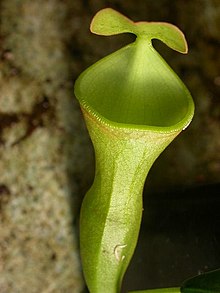Nepenthes campanulata
| Nepenthes campanulata | |
|---|---|

| |
| Klasifikasi ilmiah | |
| Kerajaan: | |
| Klad: | Tracheophyta |
| Klad: | Angiospermae |
| Klad: | Eudikotil |
| Ordo: | |
| Famili: | |
| Genus: | |
| Spesies: | N. campanulata
|
Nepenthes campanulata adalah salah satu spesies anggota dalam genus Nepenthes. Keunikan Nepenthes campanulata adalah lubang kantong yang kecil, berwarna hijau kekuningan, dan berbentuk lonceng.[1] Nepenthes campanulata tumbuh di bebatuan kapur di Kalimantan.[2] Nepenthes campanulata dapat tumbuh di tepi tebing di kawasan hutan dengan ketinggian mendekati 100 meter.[3]
Ciri khas
suntingNepenthes campanulata merupaka tipe kantong semar kering. Bibir kantung hampir tidak ada, namun lilin perekat sangat banyak. Ini memudahkan pengangkapan antropda meski di cuaca kering. Bentuk tubuh ini juga mengurangi pengeluaran cairan. Sebagian besar mulut kantong hanya digunakan untuk menangkap mangsa, sedangkan proses pencernaan makanan dilakukan di dalam kantong. Stuktur mulut kantong yang kecil tidak menjadi kerugian bagi Nepenthes campanulata. Ini dikarenakan daerah tepian tebing jarang terkena air hujan secara langsung.[4]
Referensi
sunting- ^ Clarke et al. (2014), hlm. 7."Nepenthes campanulata is one of the most unusual and poorly documented of all Nepenthes species. It is remarkable for the compact stature of the plant and its small, yellow, bellshapedc pitchers, which give the plant its species name."
- ^ Cheek, Martin dan Michal R. Golos (2019), hlm. 3."Is remarked that obligate limestone species are only known from Borneo: Nepenthes boschiana Korth, N. campanulata."
- ^ Bourke, Greg (2011), hlm. 24."A large colony of Nepenthes campanulala growing in a cliff face almost 100m above the forest floor."
- ^ Clarke et al. (2014), hlm. 12."N. campanulata pitchers represent an extreme development of the dry type pitcher format. The peristome is reduced to such an extent that it is barely visible, but the waxy zone is very highly developed. This makes the pitchers effective arthropod traps even when the weather is comparatively dry. Water loss from pitchers is minimized by reducing the digestive zone to a small area at the bottom of the pitcher, with a correspondingly small quantity of pitcher fluid. In other words, most of the surface area of the trap is devoted to capturing and retention of prey, whereas only a small part is devoted to the digestion of prey. The bell-shaped structure does not prevent rainfall from entering, but because the plants often grow beneath overhangs on the cliff face, they rarely receive large quantities of direct rainfall, so a bell-shaped pitcher with a small lid is not a disadvantage."
Daftar Pustaka
sunting- Bourke, Greg (Maret 2011). "The Nepenfhes of Mulu National Park". Carniflora Australis. 8 (1): 20–31.
- Cheek, Martin dan Michal R. Golos (2019). "Nepenthes(Nepenthaceae) on Limestone:New Discoveries": 1–5.
- Clarke; et al. (Maret 2014). "Observations of the Natural History and Ecology of Nepenthes campanulata". Carnivorous Plant Newsletter. 43 (1): 7–13. ISSN 0190-9215.